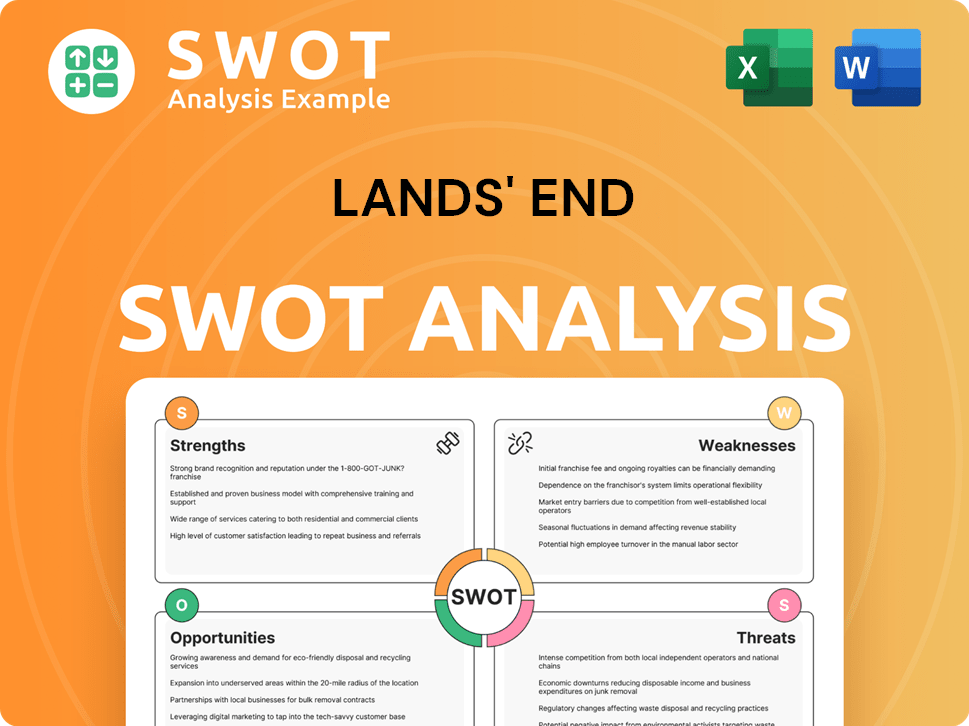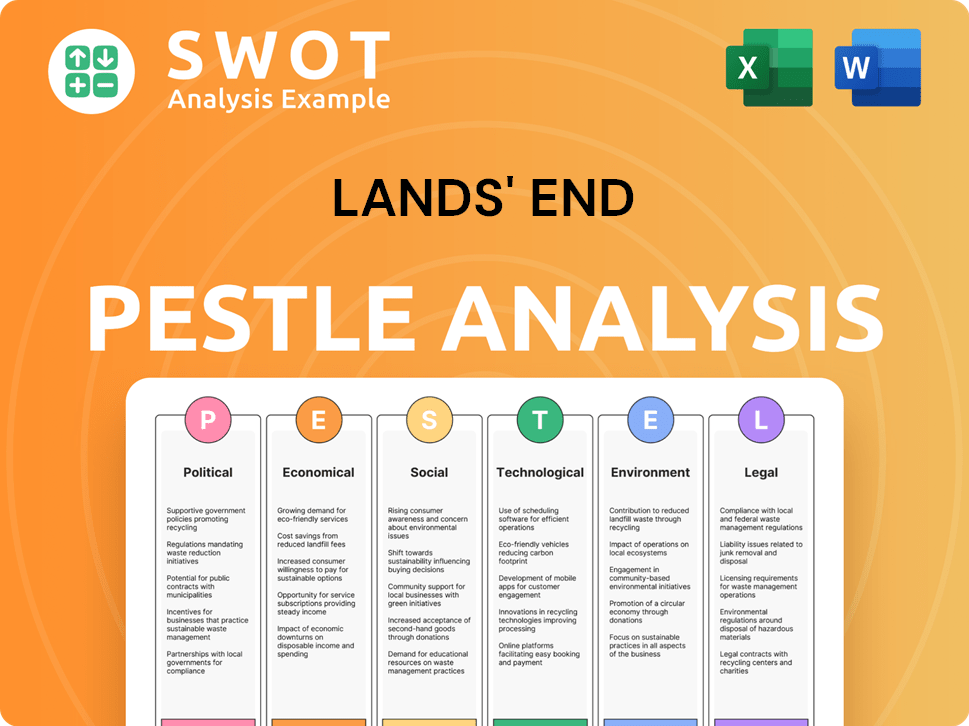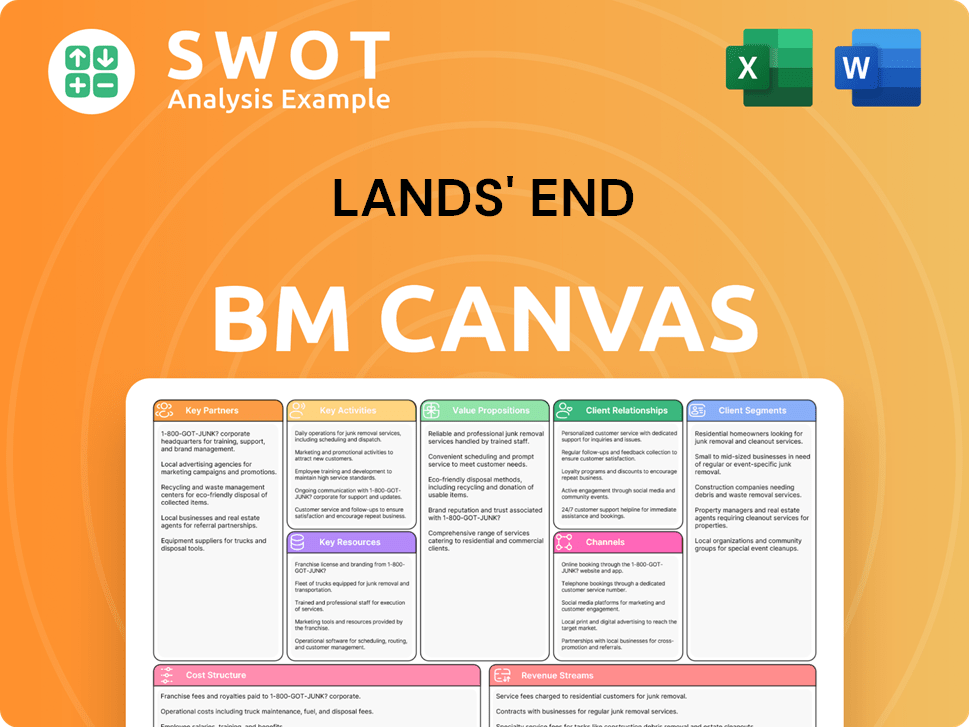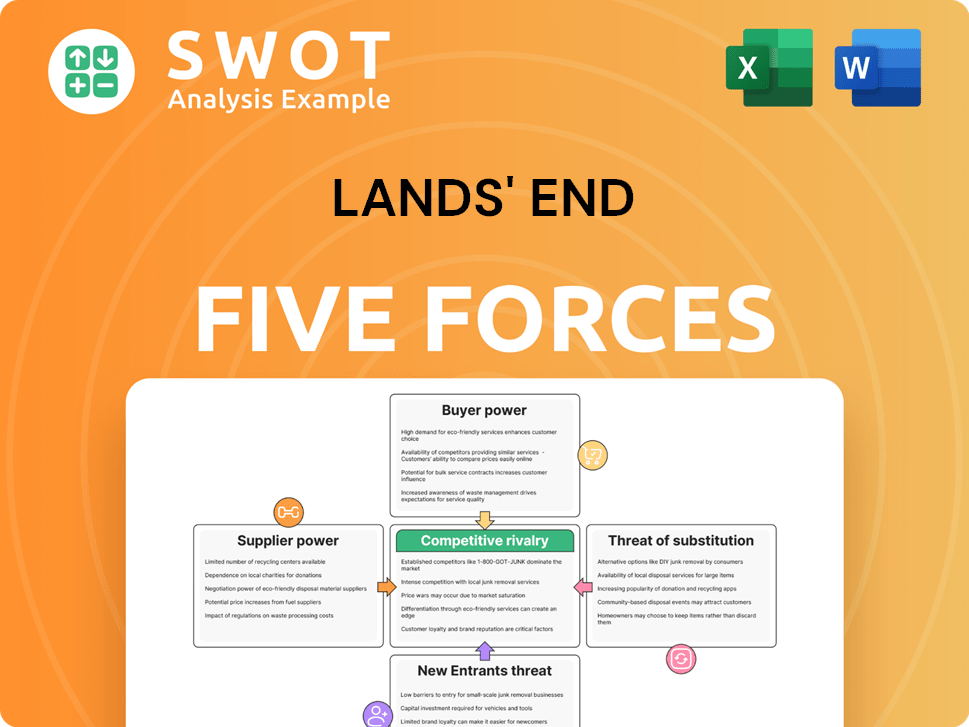Lands' End Bundle
How Does Lands' End Navigate the Ever-Changing Retail Landscape?
Lands' End, a well-known name in apparel and home goods, has a fascinating sales and marketing strategy. From its catalog roots to its modern omnichannel approach, the company's evolution offers valuable lessons. Understanding their current tactics is key to grasping their position in the competitive market. This analysis will explore how Lands' End adapts and thrives.

This exploration delves into Lands' End's core strategies, examining its Lands' End SWOT Analysis, and how it tailors its approach to its target market. We'll dissect its Lands' End sales strategy, including its digital marketing strategy and customer acquisition strategies. Furthermore, we'll examine the company's brand positioning and how it leverages its omnichannel retail strategy to drive sales and foster customer loyalty, including a look at Lands' End marketing campaigns examples and its overall Lands' End business model.
How Does Lands' End Reach Its Customers?
The sales and marketing strategy of the company, focuses on a multi-channel approach to reach its customers. This strategy includes its e-commerce website, catalogs, and physical retail locations. The company's digital presence is significant, with approximately 90% of its business conducted online, showcasing the importance of its digital platforms for streamlined operations and brand visibility.
This evolution reflects a strategic shift towards an omnichannel strategy, leveraging its historical catalog-based retail foundation. Catalogs, once the primary sales channel, are now primarily used as a marketing device to support personalized solutions and drive traffic to its core e-commerce website. In recent years, the company has also expanded its reach through third-party partnerships and online marketplaces.
The company's 'asset light' licensing strategy has proven effective for customer acquisition. This strategy has contributed significantly to growth from existing partners and channels. The licensing business saw a revenue increase of over 60% year-over-year in Q1 fiscal 2025.
The company's e-commerce website (landsend.com) is a primary sales channel. It allows for streamlined operations, from inventory management to order fulfillment. It provides improved brand visibility, with a significant portion of sales occurring online.
Catalogs, once the primary sales channel, are now primarily used as a marketing device. They support personalized solutions and drive traffic to the e-commerce website. This shift reflects an omnichannel retail strategy.
The company has expanded its reach through third-party partnerships and online marketplaces. These include Macy's, Target, Costco, Kohl's, Nordstrom, and Amazon. This 'asset light' licensing strategy has proven effective for customer acquisition.
The company operates physical retail locations, though the emphasis is increasingly on digital and licensing aspects. The number of company-operated retail stores has been in the range of 20-30 in recent years. These stores provide a direct customer experience.
In addition to direct-to-consumer (DTC) channels, the company operates an Outfitters distribution channel, offering customized products to businesses and schools. This B2B segment has shown strong performance. The company's approach involves a variety of channels to reach its target market. For more insights, explore the Brief History of Lands' End.
The company's sales strategy is built on a multi-channel approach, leveraging e-commerce, catalogs, and partnerships. The digital presence is crucial, with the website driving a large portion of sales. The company focuses on customer acquisition through various channels.
- E-commerce: Primary focus with streamlined operations.
- Catalogs: Used as a marketing tool to drive online traffic.
- Third-Party Partnerships: Expanding reach through licensing.
- Outfitters Channel: B2B segment for customized products.
Lands' End SWOT Analysis
- Complete SWOT Breakdown
- Fully Customizable
- Editable in Excel & Word
- Professional Formatting
- Investor-Ready Format

What Marketing Tactics Does Lands' End Use?
The sales and marketing strategy of the company involves a blend of digital and traditional marketing tactics. This approach aims to boost brand awareness, generate leads, and ultimately drive sales. A significant focus is placed on data-driven marketing, customer segmentation, and personalization to enhance the customer experience.
The company leverages data analytics to understand customer shopping behaviors, optimize product assortments, and improve inventory management. This comprehensive approach allows for more effective targeting and more efficient resource allocation. The company is also investing in innovative technologies, such as AI, to further refine its marketing efforts.
The company's marketing investments increased by 380 basis points in fiscal 2024 to over 41% of revenues, focusing on higher lifetime value customers. The company's growth strategy is also discussed in detail in this article: Growth Strategy of Lands' End.
The company has revolutionized its email marketing with AI-driven personalization, enabling scaled, tailored messaging and improved insights into performance. This allows the brand to deliver the right content to the right customer at the right time. The company has also expanded its SMS marketing program.
The company has launched a new AI-driven recommendation engine to enhance the customer experience. Digital marketing strategies contributed to a 5% increase in global new customer acquisition in fiscal 2024.
Traditional media, particularly catalogs, have evolved from a sales-driven approach to one focused on emotional appeal. This approach emphasizes multi-category styles and complete looks rather than just pricing, targeting a younger customer base.
A strategic relaunch in Europe, driven by localized marketing and influencer collaborations, resulted in a 28% year-over-year e-commerce sales surge in Q1 fiscal 2025, despite an overall decline in European e-commerce net revenue.
The company's SMS marketing program added nearly 400,000 new subscribers in Q1 fiscal 2025, indicating strong growth in this channel.
Digital marketing strategies contributed to a 5% increase in global new customer acquisition in fiscal 2024, demonstrating the effectiveness of these initiatives.
Lands' End PESTLE Analysis
- Covers All 6 PESTLE Categories
- No Research Needed – Save Hours of Work
- Built by Experts, Trusted by Consultants
- Instant Download, Ready to Use
- 100% Editable, Fully Customizable

How Is Lands' End Positioned in the Market?
The brand positioning of the company focuses on being a classic American lifestyle brand. It emphasizes quality, value, and service, offering durable designs for families and individuals. This approach aims to differentiate it through a commitment to quality and customer satisfaction, providing 'solution-based apparel' for everyday life.
The core message revolves around providing 'solution-based apparel' and products 'ready for life's every journey'. This positioning is anchored in its core strengths, such as swimwear and outerwear, and is being expanded to include product innovations like waterproofing and sun protection. The company's strategy includes a focus on expanding its premium brand image across all channels and geographies.
The company's strategic moves are reflected in its financial performance, with gross margin improvement as a key indicator. In Q1 fiscal 2025, gross margin increased by approximately 210 basis points to 50.8%. This was partially driven by transitioning kids and footwear inventory to licensees, which aligns with the company's focus on profitable sales. This strategic shift, coupled with less promotional activity, drove a 550 basis point gross margin expansion in fiscal 2024.
The brand emphasizes quality and durability in its products. This focus builds customer trust and fosters brand loyalty. These qualities are central to the company's identity and appeal to its target market.
The brand offers value through its pricing strategy and product offerings. It provides customers with a sense of worth. This value proposition is a key component of the company's marketing strategy.
The company prioritizes customer satisfaction through excellent service and support. This commitment enhances customer loyalty and positive brand perception. It is a core element of the company's brand positioning.
The company is committed to sustainability. The company aims to procure 100% of its cotton from more sustainable sources by 2025 and transition to 100% sustainable packaging and labeling in 2025. This commitment aligns with growing consumer demand for environmentally friendly products.
The company maintains a consistent brand image across its multi-channel presence. This approach ensures that the brand message is uniform across all customer touchpoints. A strong online presence is vital for the company's Growth Strategy of Lands' End.
- Online Sales: The company focuses on enhancing its online sales performance through its website and mobile app.
- Retail Partnerships: The company has strategic partnerships with major retailers to expand its reach.
- Catalog Sales: The company continues to utilize catalogs as a channel for sales and brand promotion.
- Social Media: The company actively uses social media platforms to engage with customers and promote its products.
Lands' End Business Model Canvas
- Complete 9-Block Business Model Canvas
- Effortlessly Communicate Your Business Strategy
- Investor-Ready BMC Format
- 100% Editable and Customizable
- Clear and Structured Layout

What Are Lands' End’s Most Notable Campaigns?
Recent marketing initiatives at Lands' End highlight a focus on strengthening its brand and driving sales. The company's strategies encompass digital engagement, strategic partnerships, and a shift towards licensing to optimize revenue streams. These efforts aim to enhance the customer experience and expand its market reach, as detailed in Revenue Streams & Business Model of Lands' End.
A key aspect of Lands' End sales strategy involves leveraging its iconic products through creative marketing campaigns. For instance, the 'viral moments' campaign around the pocket tote in Q1 fiscal 2025 successfully boosted customer engagement and drove traffic to the company's website. This approach reflects the company's commitment to digital marketing and customer acquisition strategies.
Furthermore, the company's approach includes a focus on international expansion and strategic partnerships. The European market saw significant growth, with e-commerce sales surging by 28% year-over-year in Q1 fiscal 2025, driven by localized marketing efforts. The partnership with Delta Air Lines, slated to begin in Q2 fiscal 2025, is another example of the company's strategic initiatives.
Lands' End has focused on leveraging its core products to engage customers. The 'viral moments' campaign around its iconic pocket tote in Q1 fiscal 2025 drove traffic to its website. This approach is a key part of its digital marketing strategy.
A strategic relaunch in Europe has led to significant e-commerce growth. In Q1 fiscal 2025, e-commerce sales surged by 28% year-over-year. This was fueled by localized marketing and collaborations.
The transition of kids' and footwear product lines to licensing arrangements is a key strategy. This 'asset-light' approach has led to a significant increase in licensing revenue. Licensing revenue was up over 60% year-over-year in Q1 fiscal 2025.
Lands' End is expanding through strategic partnerships. The upcoming partnership with Delta Air Lines, set to begin in Q2 fiscal 2025, is a notable example. These partnerships aim to enhance brand visibility.
Lands' End Porter's Five Forces Analysis
- Covers All 5 Competitive Forces in Detail
- Structured for Consultants, Students, and Founders
- 100% Editable in Microsoft Word & Excel
- Instant Digital Download – Use Immediately
- Compatible with Mac & PC – Fully Unlocked

Related Blogs
- What are Mission Vision & Core Values of Lands' End Company?
- What is Competitive Landscape of Lands' End Company?
- What is Growth Strategy and Future Prospects of Lands' End Company?
- How Does Lands' End Company Work?
- What is Brief History of Lands' End Company?
- Who Owns Lands' End Company?
- What is Customer Demographics and Target Market of Lands' End Company?
Disclaimer
All information, articles, and product details provided on this website are for general informational and educational purposes only. We do not claim any ownership over, nor do we intend to infringe upon, any trademarks, copyrights, logos, brand names, or other intellectual property mentioned or depicted on this site. Such intellectual property remains the property of its respective owners, and any references here are made solely for identification or informational purposes, without implying any affiliation, endorsement, or partnership.
We make no representations or warranties, express or implied, regarding the accuracy, completeness, or suitability of any content or products presented. Nothing on this website should be construed as legal, tax, investment, financial, medical, or other professional advice. In addition, no part of this site—including articles or product references—constitutes a solicitation, recommendation, endorsement, advertisement, or offer to buy or sell any securities, franchises, or other financial instruments, particularly in jurisdictions where such activity would be unlawful.
All content is of a general nature and may not address the specific circumstances of any individual or entity. It is not a substitute for professional advice or services. Any actions you take based on the information provided here are strictly at your own risk. You accept full responsibility for any decisions or outcomes arising from your use of this website and agree to release us from any liability in connection with your use of, or reliance upon, the content or products found herein.